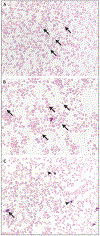Case 8-2023: A 71-Year-Old Woman with Refractory Hemolytic Anemia
- PMID: 36920760
- PMCID: PMC10133839
- DOI: 10.1056/NEJMcpc2211370
Case 8-2023: A 71-Year-Old Woman with Refractory Hemolytic Anemia
Figures



References
-
- Bendapudi PK, Hurwitz S, Fry A, et al. Derivation and external validation of the PLASMIC score for rapid assessment of adults with thrombotic microangiopathies: a cohort study. Lancet Haematol 2017;4(4):e157–e164. - PubMed
-
- Cuker A, Cataland SR, Coppo P, et al. Redefining outcomes in immune TTP: an international working group consensus report. Blood 2021;137:1855–61. - PubMed
Publication types
MeSH terms
Grants and funding
LinkOut - more resources
Full Text Sources
Other Literature Sources
